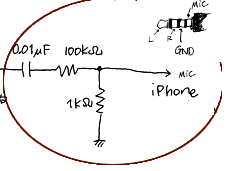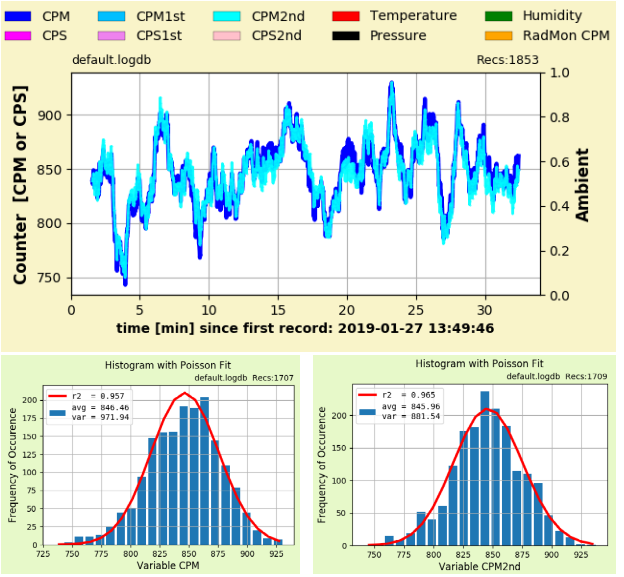| Author |
 Topic Topic  |
|
|
n8xyn
   
USA
66 Posts |
 Posted - 01/01/2019 : 14:12:44 Posted - 01/01/2019 : 14:12:44


|
| What is the jack beside the usb connector on the GMC 500 and how can it be used? |
Jim Whitaker |
|
| Reply #1
donghelan
   
Japan
65 Posts |
 Posted - 01/04/2019 : 01:08:26 Posted - 01/04/2019 : 01:08:26


|
Jim,
That is audio output.
The only thing you can hear are the dry radiation detection clicks when "speaker" is on.
You could connect that to a iphone audio input (with a proper resistor network in between to match impedance).
The free "Geigerbot" app by Nick Dolezal is the best iphone software to deal with Geigercounter audio signal processing.
cheers and all the best for 2019!
Fred
See a matching network example attached,
[edit] You don't want to hear this sound in your head phones.
and
the circuitry is maybe too simple without Galvanic isolation however I had never any problem with it during radiation monitoring in 2011-2012.
It is better practice to design a circuit with a transformer or opto coupler to separate geiger counter signals from smart phones ;)
and
100k was too much. Just put a 100k trimmer instead to find the right level.
Image Insert:

16319 bytes |
To bug or not debug, that is the Q |
Edited by - donghelan on 01/04/2019 05:28:47 |
 |
|
| Reply #2
n8xyn
   
USA
66 Posts |
 Posted - 01/08/2019 : 17:38:23 Posted - 01/08/2019 : 17:38:23


|
| Is it useful for those programs just wanting a click output? |
Jim Whitaker |
 |
|
| Reply #3
donghelan
   
Japan
65 Posts |
 Posted - 01/12/2019 : 18:45:21 Posted - 01/12/2019 : 18:45:21


|
Every click is a count adding to the Counts-Per-Minute.
The software can be set to trigger on rising or falling edges and trigger level.
Using sound input ports there probably is maximum sample rate (and therefor count rate) of about 4 times the maximum acceptable audio frequency.
Assume conservatively 16kHz times 4 is 64000 Samples /sec. Lets assume then that 16000CPS is possible (i never tried;)) then maximum 960000 CPM would be possible to detect. However I read somewhere that iphone can sample audio input at 192kHz. So potentially could be 3 times higher. |
To bug or not debug, that is the Q |
Edited by - donghelan on 01/12/2019 18:47:12 |
 |
|
| Reply #4
EmfDev
    
2379 Posts |
 Posted - 01/14/2019 : 15:27:57 Posted - 01/14/2019 : 15:27:57


|
| donghelan is correct. It can output clicks that can be recorded/used by other devices. |
 |
|
| Reply #5
GBG12
    
Canada
103 Posts |
 Posted - 01/23/2019 : 15:41:09 Posted - 01/23/2019 : 15:41:09


|
| Or it can be used with earbuds if you want to discreetly monitor for hot spots... |
 |
|
| Reply #6
ullix
    
Germany
1237 Posts |
 Posted - 01/27/2019 : 06:03:43 Posted - 01/27/2019 : 06:03:43


|
Inspired by these posts I did some tests.
Connect an (old! - I was careful) stereo-headphone (3.5mm plug with 3 connection rings), and you can hear the clicks. No damage to the headphone!
Connect a 3.5mm Male to Male Stereo Audio Cable (like this: https://www.amazon.com/AmazonBasics-3-5mm-Stereo-Audio-Cable/dp/B00NO73MUQ ) on one side with the jack on a GMC-300E+ counter, and on the other side with the microphone input of my (Linux-)computer, and I could hear the clicks and record the clicks to file.
Next thing was to make GeigerLog listen to the sound, and count the pulses. Piece o' cake. Here are the results:
Image Insert:

133515 bytes
I tested with a GMC-300E+ counter. As usual, the dark-blue curve is from the CPM output, collected as digital signals, and mapped in GeigerLog as "CPM", all standard. The cyan-blue curve is the signal collected from the very same counter's audio output, counted by GeigerLog, and is mapped to CPM2nd. Likewise the corresponding CPS signals (not shown)
The average of the two curves over an about half hour data collection is CPM=846.5, and CPM=846.0, resp. I think this is acceptable :-)
Of course, the two CPS curves also look identical, but given their much bigger scatter, that is less impressive (avg CPS=14.07 vs. 14.09).
The two Poisson curves leaves nothing to be desired. The audio Poisson curve looks a tad nicer, but that is plain statistics, both are as perfect as possible for rē=0.96.
So, I am making this audio-recording to a standard in the next GeigerLog version. This will allow to record with any Geiger counter, which outputs an audio signal, be it one of the cheap home-brew versions, or one of the old WWII style, flat-iron type clunkers.
And, not to forget, the most modern PIN-Diode based counters like the SGP-001, which I had reviewed here: http://www.gqelectronicsllc.com/forum/topic.asp?TOPIC_ID=5584 can now also be measured and recorded with GeigerLog on a PC (Linux, Win, Mac), and not just on an Android or iphone device.
|
 |
|
| Reply #7
donghelan
   
Japan
65 Posts |
 Posted - 01/28/2019 : 06:41:58 Posted - 01/28/2019 : 06:41:58


|
Nice job @ullix! Thumbs-up.
I think you mean cold-war style (army green) i/o WWII style. Anyway they look antique.
I had two West German counters in 2011. And I still have one digital East German made after the Chernobyl disaster.
Conrad had them in stock in the 1990-ies, long after the wall came down . Really made for heavy radiated environment ;) |
To bug or not debug, that is the Q |
 |
|
| Reply #8
PiR
 
Belgium
26 Posts |
 Posted - 04/23/2019 : 04:22:22 Posted - 04/23/2019 : 04:22:22


|
Hi,
I DON'T KNOW ANYTHING ABOUT ELECTRONICS.
Maybe It was just LUCK that I did'nt BURN any of my devices.
So DO NOT DO THIS AT HOME ;)
(... and sorry for my bad English)
I used the GMC 500 output jack to AMPLIFY the sound of the clicks. I needed this so the mic on the robot I used would "ear" the clicks "louder" than the motors noises.
I simply used what I had at home:
- standard stereo jack (video #1)
- custom jack to USB that came bundled with the speaker (video #2)
https://www.lagaffe.dlvx.be/thymium/
It's just for fun, nothing scientific in there. |
 |
|
| Reply #9
ullix
    
Germany
1237 Posts |
 Posted - 04/24/2019 : 04:43:13 Posted - 04/24/2019 : 04:43:13


|
@PiR: I guess this is one of the technologies that sees the light of day "just because you can" ;-))
On a more serious note, you can create the same type of driving by simply calling the Poisson distribution function within whatever CPU and OS you are using. It saves you connecting any counter to your system, like this function for Python: https://docs.scipy.org/doc/numpy/reference/generated/numpy.random.poisson.html |
 |
|
| Reply #10
PiR
 
Belgium
26 Posts |
 Posted - 04/26/2019 : 04:34:39 Posted - 04/26/2019 : 04:34:39


|
quote:
Originally posted by ullix
@PiR: I guess this is one of the technologies that sees the light of day "just because you can" ;-))
At last: somebody who underdestand me ;)
When I saw the jack on the GQ GMC 500, I though: "Hmmm, what can I do with this ?"
quote:
On a more serious note, you can create the same type of driving by simply calling the Poisson distribution function within whatever CPU and OS you are using. It saves you connecting any counter to your system, like this function for Python: https://docs.scipy.org/doc/numpy/reference/generated/numpy.random.poisson.html
Yes, you're right; I didn't think about it. I have bad memories of Poisson at IT school (long ago) ;)
As said above, the goal was to have a complex machine to do a simple task.
I used a GMC because I had one. It could have been a UV meter, magnetic filed, ... which I don't have.
When I began this "project" I had no real idea of what it would be exactly. Maybe using some "radioactive" sources and have the robot avoid them. The only free source I have is sub-products (I think) of home Radon (with a ballon ...). And it's not very easy to use. So a distribution was not something I was thinking of. I ended up doing simple pseudo-random moves changes.
Moreover, the robot programming language is minimal + only 8bits integers.
It seems possible to use Python (which I never used) + D-Bus interface (linux) + what they call "asebamedulla" and have a real CPU doing computations (and avoid using the speaker).
Well, I should learn basic Python (should be easy), D-Bus (harder) and the "custom university-made" asebamedulla (subject to changes).
That will be for another "project", if I've got enough spare time (I've got somthing on mind but it's not GMC realated.)
As you might have notice, I randomly stubled on this "jack" topic and I just shared my "experience" so people see it's possible to amplify the sound.
In fact, I was just wondering what is the "tube voltage" setting in the GQ GMC 500 (and did not find the answer, so I didn't change anything)
Again, @ullix, thanks a lot for sharing your thoughs with me. I might use it later.
|
 |
|
| |
 Topic Topic  |
|

